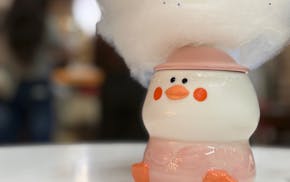Artist Ryan Stopera slapped a stencil outline of George Floyd's face over a plywood board painted deep purple. Sheets of wood covered the street-facing windows of Fallout Urban Arts Center in the Whittier neighborhood, one of countless boarded-up Twin Cities buildings being transformed with paint and passion.
Stopera held the stencil in place while another artist shook a can of gold spray enamel and took aim at the cutup paper.
"Art can be an expression of prayer, a hope for the future, and a way of dealing with systemic racism," said Pastor Peter Wohler, executive director of Source MN, a faith-based organization that sponsors the Fallout and works with at-risk populations.
In the wake of last week's riots, hundreds of artists around the city are transforming boarded-up windows with messages of remembrance, hope, demands for justice, healing community and pride for minority-owned businesses. Some create their own variations of Floyd's familiar portrait. All are infusing powerful, positive energy during a painful time of growth and reconciliation.
"I think a lot of people have found themselves in this space of 'What to do?' and some of us went to art," said Stopera. "Even the act of painting is so meditative — and this is traumatic."
Using the hashtag #creativesaftercurfew, Stopera, Leslie Barlow and 20 to 30 other predominantly BIPOC (black/indigenous/people of color) artists are part of one crew painting murals on boarded-up businesses.
They received $5,000 from the Graves Foundation, discounts on paint supplies and free brushes from Wet Paintin St. Paul. Blick Art Materials chipped in $2,000 toward future murals. There's no time to apply for grants, so donations are essential.
"There's a momentum right now with everything that happened," said artist Mackenzie Owens, who joined on Day 2 of painting. "We've got to get out."
As of Thursday the crew had done five murals. The boards could stay up for three to four weeks, and the crew has 20 businesses on deck. They focus on BIPOC businesses, with BIPOC artists developing the mural messaging.
At Fallout, Wohler gave the artists free rein to do whatever they wanted on its big boarded-up windows. The pastor sees a double injustice in the wake of Floyd's death: the perpetuation of systemic racism and the destruction of immigrant-run businesses. Murals, he believes, are one way to combat visual signs of violence that the charred storefronts on Lake Street represent.
The artists work quickly. The two-panel mural — showing Floyd, silhouettes of people with a pair of brown hands holding nutritious food, and a phoenix rising from the ashes — was painted by 15 community members in about 11 hours.
Last-minute location change
Everything is done on the fly, making plans flexible and often last-minute. The artists moved to Fallout after their plan to paint the soon-to-be demolished Kmart on Lake Street fell apart.
Barlow thought of painting large hands holding up phones, symbolizing how people are getting the word out through social media, but on the screens they'd paint images of the future they wanted to see, whether it was "abolish the police" or "housing for all."
Kmart had been working with Wohler on the mural idea — that morning, volunteers from the Fallout had whitewashed over graffiti there — but then a store manager came out to talk with the artists.
"I don't want this to be a mural with a political message one way or the other," said the manager, who would only identify himself as Dan. "We don't want to be on either side, we just want to be out of the middle."
"The problem is that people don't want to take a side," said Barlow. "You are a business in a predominantly black and brown neighborhood."
The artists asked if there were any words or images he preferred. Dan suggested words like "peace" or a mural with flowers. The artists packed up their supplies.
When asked why the artists felt it was important for the mural to be here, Barlow pointed to Kmart's location in a heavily Latino and immigrant community, just one block from the 5th Precinct police station that was under siege just days before.
"It's right here, in the middle of the community."
Mystery muralists
Hisham Hassan, owner of the pizza shop A Slice of New York in the 2400 block of Nicollet Avenue, got a message from a friend that someone had painted a mural on his boarded-up front window.
A portrait of a black man wearing a bright orange shirt popped out against a light orange background. He had no facial features. Two fists holding orange-and-white patterned cloths appeared under blue-outlined yellow-and-orange letters with the text "George Floyd!"
"I want to keep this," said Hassan. "It's too big, but I will find a place. It is a part of history."
Hassan had no idea who the artist was, but he welcomed the mural's presence.
"Maybe the sadness, maybe something good will come of it," he said. "Maybe, people will wake up and understand."
612-673-4437 • @AliciaEler

The 5 best things our food writers ate this week

A Minnesota field guide to snow shovels: Which one's best?

Summer Camp Guide: Find your best ones here

Lowertown St. Paul losing another restaurant as Dark Horse announces closing

